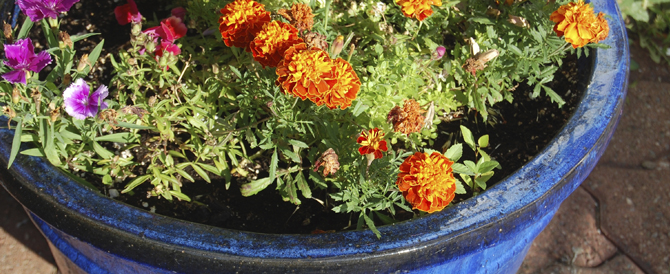If you’re new to deck or patio gardening, you may be wondering exactly what “plantscaping” is. Plantscaping is a relatively new term used to describe the addition of greenery to man-made exterior structures – like decks, patios, gazebos, etc. Basically, it’s landscaping without the land by creating a container garden within or attached to a structure!
For today’s post, we’re going to give you some of our tips to help you get started in plantscaping your outdoor area!
Tip 1 – Don’t Spend Tons on Your Containers
Fancy decorative planters are nice, but they can get very expensive especially if you have a large area in which you’re plantscaping. You can stretch your budget by using 5-gallon buckets, which you can pick up from Home Depot for less than $3. They offer ample space for plants, are easy to transport and can be painted for a look that’s all your own. All you have to do is drill holes in the bottom for drainage, and you’re ready to plant.
Tip 2 – Plan Out the Design You’re Looking to Achieve
Before hitting your local garden center, you should definitely put some thought into the overall look or theme you’d like to achieve. Both your containers and your plants can create a powerful statement through color, texture and even smell. Sketch out a basic plan for your space and figure out where you’d like to place things before you purchase the materials. You may find that you have more or less space that you originally thought once you diagram it out.
Tip 3 – Go Vertical
Don’t overlook your vertical space that is available on decks, trellises and gazebos. Putting plants up higher and hanging them can help to better define the space. Consider placing containers up on the railing or add pedestals for them to sit on. This approach allows more flexibility and a greater variety in options to create the perfect atmosphere.
Tip 4 – Change It Up
One big advantage to a container garden over one that’s rooted in the ground is that you can easily move things around until you get the perfect layout. Or if you feel like changing things up frequently it’s as simple as moving a few containers. Remember to keep colors, textures, and size in mind when deciding where to place your plants.
Tip 5 – Place Plants Around the Perimeter of Your Deck or Patio
Create a smooth transition and a natural “barrier” from your container garden to the yard by planting around the perimeter of the deck or patio. This creates the illusion of separate space without the permanence of a dividing wall, while adding that natural feel that blends perfectly with your yard.
Tip 6 – Don’t Forget to Make it Comfortable
Although your plants and containers should be the main focus of your plantscaped outdoor space, you still want to be able to enjoy the space to kick back and relax. Consider adding elements like a bistro table and chairs, built-in cushioned seating, a recliner, etc. Whatever you choose, just be sure it’s sized appropriately so that it doesn’t overwhelm the garden space.
Tip 7 – Create Container Bouquets
You don’t have to limit yourself to one type of plant per container. You can pair different plants and flowers together in a single container to create a unique bouquet look. Just make sure there’s ample space for all the plants so they won’t overtake each other.
Tip 8 – Make Sure You Choose Ideal Container Plants
Some plants thrive in containers while others prefer to be in the ground. Do your due diligence and research for soil preference, sunlight needs, and hardiness of each plant you plan to incorporate.
Tip 9 – Colorful Containers Ensure a Year-Round Rainbow
Your container garden will be in full bloom in the spring and summer which adds a plethora of color to your outdoor space, while the fall and winter are a different story. Trying to utilize colorful containers will keep things bright and cheerful all year ‘round!
Tip 10 – Use the “Thriller, Filler and Spiller” Method
When putting together your container bouquet, keep the “thriller, filler and spiller” method in mind. Thriller plants have some height and are planted right in the middle of the pot. The filler is a shorter plant that goes around the thriller. The spiller is planted around the edge so it drapes over the sides.
Plantscaping is a great way to make creative use of your deck, patio, or gazebo, as well as increase your backyard privacy and add greenery even if you don’t have much yard space. Use the 10 tips above to transform your custom deck or patio into a colorful container garden.
*image: makedadance/Thinkstock

